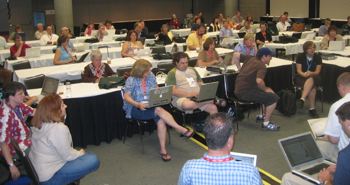 It seemed, to this edtech adventurer, that Twitter was the resounding hit of NECC, at least among the international gathering of edubloggers, and from the perspective of pure geek appeal. It was interesting to hear stories of folks who announced outstanding sessions in progress on their Twitters and having their Friends appear only moments later, searching for seats. I used it, via my mobile phone, to share with folks the exhibitor booths that offered chocolate to weary tech wanderers.
It seemed, to this edtech adventurer, that Twitter was the resounding hit of NECC, at least among the international gathering of edubloggers, and from the perspective of pure geek appeal. It was interesting to hear stories of folks who announced outstanding sessions in progress on their Twitters and having their Friends appear only moments later, searching for seats. I used it, via my mobile phone, to share with folks the exhibitor booths that offered chocolate to weary tech wanderers.
But the tool has continued to nag at me, especially as many of the twittersations have continued, and especially after a conversation I had with Linworth Publishing’s Cynthia Anderson on Monday. Over drinks (diet coke for me) we’d asked each other about what had impressed us at the conference and I commenced to describe Twitter — not an easy task. Up to then, I had not even considered instructional applications — still trying to come to grips with its overall basic functions. But Cynthia pushed me to explore some possibilities.
First of all, Twitter is probably not the tool to use. I’ve not thought it through, but I suspect that there might be security issues. But a Twitter type application in the classroom might work something like how Apple’s Francis Sheppard described it to me in an airport a couple of weeks ago, “micro blogging.” Children are reading in class and every ten minutes they are asked to interrupt their reading and post a Twitter post (no more than 140 characters) describing their current impressions, “Wait till you get to what happens in the cave!”
You might require students to have access to all of their classmates Twitter posts, but what if you required them to select Friends, and lets say that those three or four classmates are the only posts you have access to. Friends could change. Students could drop them, and add them at will, but an unspoken, but very real goal would be to earn as many Friends as you can, people who are interested in reading your Twitter messages. You’d want to write well and interestingly. It may be helpful to use pseudonyms so that RL popularity would not enter into the equation, or it may be best to keep real names. Twitters would only be available to classmates.
Or encourage students who are learning through a language other than their native tongue, to use Twitter to support each other. Allow them to use their native language to help each other where difficulties with their second language or culture arrise.
What do you think?
Should I consider adding a Twitter type feature to Class Blogmeister?

 It’s easy to attend and participate in something like the EduBloggerCon and to sit and teach and learn through casual and potent conversations and pat ourselves on the back and say, “look at me! I get it!” There was so much energy in that experience, we can’t help it.
It’s easy to attend and participate in something like the EduBloggerCon and to sit and teach and learn through casual and potent conversations and pat ourselves on the back and say, “look at me! I get it!” There was so much energy in that experience, we can’t help it.